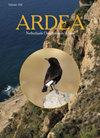丹麦环纹大蟾蜍冬季分布的长期变化
IF 1.3
4区 生物学
Q3 ORNITHOLOGY
引用次数: 5
摘要
我们描述了1940年至2018年间,丹麦94352只大Cormorant幼鸟的2249只新死亡的冬季复苏鸟的分布的长期变化。整个越冬范围被分为四个主要区室,以评估(1)迁徙距离和(2)恢复的空间分布的变化。在东南部越冬区,从1946/47–2000/01年冬季到2001/02–2018/19年冬季,到冬季恢复点的平均距离减少了528公里(相当于减少了36%)。在中南部越冬区,从20世纪80年代中期之前到2006/07–2018/19年冬季,变化是渐进的,减少了约700公里(相当于41%)。在西南越冬的Cormorants迁徙距离没有随时间变化。从1991年起,西南分区的回收率不断增加(从1946/47年至1990/91年的21%增加到2001/02年至2018/19年的60%)。截至20世纪90年代中期,中南部地区的回收率在34%至45%之间,然后在2006/07年至2018/19年冬季降至4%至6%。在1990/91年之前,东南分区的恢复比例从9%到18%不等,但随后下降到0.6%到2%。克罗地亚恢复的Cormorants地理起源的长期变化进一步证实,东南部越冬区恢复的丹麦环纹Cormorantes数量的下降反映了冬季分布的真正向西转变。克罗地亚的恢复情况表明,东南部的越冬区越来越多地由波罗的海中部和东部繁殖地的Cormorants占据。我们得出的结论是,从20世纪90年代开始,丹麦Cormorant将其冬季分布向西转移,并通过进一步向北过冬缩短了迁徙时间。我们假设,这种向西的转变代表了与波罗的海东部繁殖地鸟类竞争加剧的反应,自20世纪90年代以来,波罗的海的种群数量显著增加。本文章由计算机程序翻译,如有差异,请以英文原文为准。
Long-Term Changes in Winter Distribution of Danish-Ringed Great Cormorants
We describe long-term changes in the distribution of 2249 freshly dead winter recoveries of 94,352 Great Cormorant chicks ringed between 1940 and 2018 in Denmark. The entire wintering range was divided into four major compartments to assess changes in (1) migratory distance and (2) the spatial distribution of recoveries. In the south-eastern wintering compartment, the mean distance to winter recovery sites declined from the winters 1946/47–2000/01 to those of 2001/02–2018/19 by 528 km (corresponding to a reduction of 36%). In the southern-central wintering compartment the change was gradual from before the mid-1980s to the winters 2006/07–2018/19 with a reduction of c. 700 km (corresponding to 41%). There were no temporal changes in migration distance for Cormorants wintering in the south-west. From 1991 onwards, recoveries were recorded in increasing proportions in the south-western compartment (from 21% in 1946/47–1990/91 to 60% in 2001/02–2018/19). The proportion recovered in the southern-central compartment varied between 34 and 45% up to the mid-1990s and then fell to 4–6% during the winters 2006/07–2018/19. The proportions recovered in the south-eastern compartment ranged from 9 to 18% until 1990/91 but fell subsequently to 0.6 to 2%. Long-term changes in the geographical origin of Cormorants recovered in Croatia further confirm that declines in numbers of recoveries of Danish-ringed Cormorants in the south-eastern wintering area reflect a true westward shift in winter distribution. The composition of recoveries in Croatia revealed that the south-eastern wintering areas were increasingly dominated by Cormorants from breeding colonies in the central and eastern Baltic region. We conclude that Danish Cormorants shifted their winter distribution westward from the 1990s onwards and shortened their migration by wintering further north. We hypothesise that this westward shift represents a response to increased competition with birds from breeding colonies located further east in the Baltic Sea, where populations increased markedly from the 1990s onwards.
求助全文
通过发布文献求助,成功后即可免费获取论文全文。
去求助
来源期刊

Ardea
生物-鸟类学
CiteScore
2.10
自引率
0.00%
发文量
49
审稿时长
>12 weeks
期刊介绍:
Ardea is the scientific journal of the Netherlands Ornithologists'' Union, and is published since 1912. The journal welcomes manuscripts reporting significant new findings in ornithology, in particular those covering the ecology, life history, and evolution of birds, and including sound descriptive work. Ardea publishes Original research papers, Short notes and Book reviews. In addition to the regular three issues per year, Ardea publishes specials that contain conference or workshop proceedings (produced on request).
 求助内容:
求助内容: 应助结果提醒方式:
应助结果提醒方式:


